![]()
By Treischel

Even if you're wrinkled with age,
And your Life has reached the Ancient Stage,
And you may have a tangled Root,
Put forward your Best Foot
| Author Notes |
Root - the way Anericans pronounce it, it rhymes with foot. The British might be tempted to pronounce it in a way tha rhymes with shoot.
Animated stills -When inanimate objects take on life or humanistic attributes. I couldn't resist this obvious subject taken from a root found along the Mississippi River bank near Harriet Island. I just had to pen this verse. Hope you like it. |
![]()
By Treischel
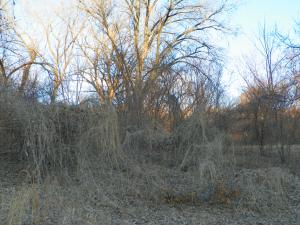
After dark on Summer's Eve they sashay,
Beneath the silver shade at river's edge.
Cavorting, dancing, prancing hand in hand,
Dancing were Witches of the meadow glade.
Enchanting - Giselle, Xena, Marilee,
Flowing in circles go the haunting three.
Giselle's lilting laughter filling the night,
Having a grand, and joyous holiday.
Into the night they danced and pranced, and sang.
Just wistful wraiths whirling the hours away,
Keeping the cackling spirit world at bay,
Lest Lucifer and his fiends come to stay.
Marilee merrily marching, matching beat.
Naughty! Pulsing, insatiable heat!
Offering their spirits to god - Mother,
Praying here for the gift to be bequeathed.
Quaking, praying, shaking with a shiver,
Rapping with jungle music all around,
Surrounded by the eerie night time sounds.
To them a question comes from hot thin air,
Unspoken but felt deep within their souls.
Very close, it whispered on the wind,
"What would writhing Witches want?" the god said.
Xena replied "Oh! Just to fly away."
Yes! The Queen of Nature released the spell.
Zoom! On Brooms, the grass witches flew away.
| Author Notes |
I wrote and posted this poem in 2012, but brought it back now to reintroduce the three witches for future tales. Each line starts with a letter of the Alphabet, and is also rhymed. I tell a story here too.
Three Young Witches get their wings, so to speak. Here I introduce them for the first time: Giselle, Xena, and Marilee. These three may show further in my work. This Aebecedarian type Poem is based on this photograph I took in February along the Mississippi River bank at Hidden Falls in Minnesota. When I first saw the image, I thought it reminded me of forest spirits, Wraiths if you will. Dancing in the forest. It's what I call an Animated Still Animated Still - Animated stills are poems where inanimate objects take on human forms, traits, or articles. They are derived from Photographs I have taken, that have moved me to write a poem associated with it. |
![]()
By Treischel
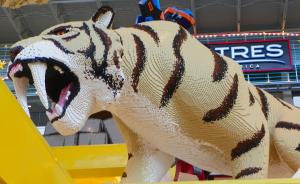
As I rounded the corner, I Blinked
At a Cat whose features are Distinct.
So let me be quite Succinct.
I think that Sabertooths are Extinct.
So wouldn't it be a pity
To be pounced on by THIS Kitty?
| Author Notes | I took this picture at LEGO Land in Mall of America, Bloomington, Minnesota. That place is Amazing. |
![]()
By Treischel
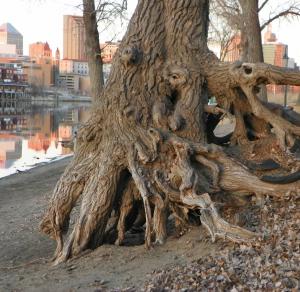
Along the River banks they lurk.
The Ancient ones of Earth
They whistle, watch and smirk
At all Humanity's civic work.
They often wonder at the worth
Of cutting all their fellow Trees
That once swayed here in the breeze.
| Author Notes |
Animated Stills - Animated stills are poems where inanimate objects take on human forms, traits, or articles. They are derived from Photographs I have taken, that have moved me to write a poem associated with it.
This Photograph was taken along the Mississippi River at Harriet Island. This is an undoctored image. The root actually looks like that. The City in the background is St. Paul which is directly across the river. |
![]()
By Treischel
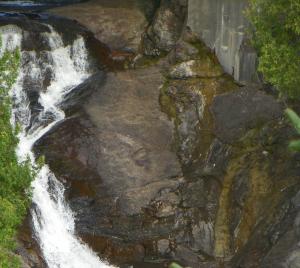
The Face in the Falls
You may wonder about the Sin
That imprisoned him within
Those mossy granite walls,
The Face within the Falls
You can see his silent moan,
As he struggles here alone
And the echo of his calls
As he emerges from the Falls.
Who is this ancient soul?
What was his fateful role?
His fate remains unknown.
Eternally locked inside the stone.
| Author Notes |
This image is from a photograph I took of the Cross River Falls on the North Shore of Minnesota. I didn't really notice the face until I downloaded the image onto my IPAD. Actually there is more than one face in this falls, but I was inspired by the large one you should be able to see if you focus on the nose.
This uses what I call an Animated Still Animated Still - When inanimate objects take on life or humanistic attributes or accessories. |
![]()
By Treischel

HOO DOO 1
Up by the river bank the Hoo Doo Howl,
Their Erie sound Haunting the Forest Height.
You might mistake it for merely an owl
Or a Werewolf stalking the Shadowy Night
In the grasses they hide by the watery path
So consider your course whatever you do
Stay clear of their Haunts, or incur the Wrath,
Of a frightening Forest type Hoo Doo.
| Author Notes | This is an Animated Still from a photograph I took along the Path at Harriet Island in the Mississippi near St. Paul, Minnesota. I had just passed it, looked over my shoulder, and snapped the shot in about two seconds without really thinking about it. When I got home and reviewed the pictures I had taken that day, this image of a howling head really grabbed me. |
![]()
By Treischel
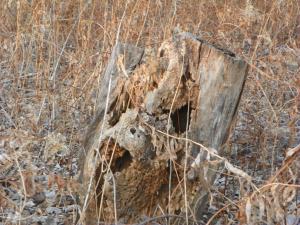
HOO DOO 2
Howl Haunting Hoo Doo!
Blow at the Wind like you do.
Piercing Screams that go through
The Night, that Clings like New Dew,
Are the Soulful Songs that draw You
To the Fate that Lies before you.
Banshees, Ghouls, and VooDoo!
Howl away! Howl away dreaded Hoo Doo!
| Author Notes |
This is another poem inspired by this photograph.
Why a second one? I had originally entered this photograph, with poem, in a contest, but had some problems with it, and I missed the deadline. Since I couldn't enter the same one, I had to write a new poem for it. So, this is the second one. Which do you like better? |
![]()
By Treischel
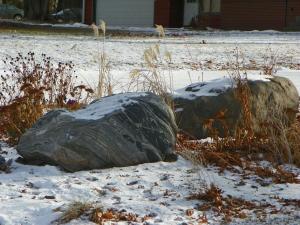
Slumber Deep! Slumber Well!
I wonder what the Eons Tell.
While you slept the World moved on,
Dust and sand to rest your heavy head upon.
While you dreamt, there grew a flower bed,
That centuries since have long fallen dead
As you calmly slept, silent snowflakes fell.
Rain fell, too many times, for the Bards to tell.
Did you Freeze here? or, Are you really dead?
How long has it been since you awoke?
Or walked, or ate, or even spoke?
Were you here when Noah's water rose?
Or when the Glaciers ruled in icy flows?
Did Aztecs offer you a bloody sacrifice,
Tossing innocent babes off a high precipice?
Did Mammoths crush you with their mangey toes?
Did you witness Christ when the bread was broke?
I do not hear those slumber sounds!
You must have weighed a million pounds!
So hard to measure that massive girth,
When so much is buried down in the Earth.
You must have grown to 10 feet tall!
Have you broken things when you took a fall,
And left a furrowed field of mighty mounds?
Did you cry out? or feel nothing at all?
Now you lie there in that sweet repose,
With buried chin and crumpled nose.
How many fevered feet have trampled through,
Before Mother Earth has come and buried you?
You lie there, a giant in such silent sleep,
Such ancient secrets still buried deep
As more millennium have marched on by,
We don't know the How, When, or Why.
| Author Notes |
Broken Idol? or Colossal statue?
This photograph is one I took in the front yard of a house along Lower Afton Road in St. Paul, Minnesota. I saw a face in the stone decorating the driveway. The whole shot reminded me of a broken giant statue head of a god from ancient times with other pieces strewn about. This inspired another of what I call Animated Stills. Animated Stills - Animated stills are poems where inanimate objects take on human, animal, or spirit forms, traits, or articles. They are derived from Photographs I have taken, that have moved me to write a poem associated with it.Two Troubadours turned into craven chumps! Terrorized! Quaking! Frightened by some stumps! |
![]()
By Treischel

the whole world is changed
reality slips away
feel so uprooted
| Author Notes | The photograph is from my personal Animated Still Collection |
![]()
By Treischel
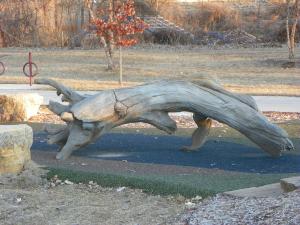
Snuffle
Sniffle
Rumble
Stumble
Scratching in mud and sniffing at plants
On the menu - juicy little Ants
| Author Notes |
Searching for a tasty lunch
This is a photograph I took of a log. It reminds me of an anteater Animated stills are poems where inanimate objects take on human, animal, or spirit forms, traits, or articles. They are derived from Photographs I have taken, that have moved me to write a poem associated with it. |
![]()
By Treischel

Within dark Forest deep they blithely walked
Surrounded by beauty most fine. Divine!
Two Troubadours ambled along and talked
With mellow cheer, time passed, imbibing wine.
When soft stark silhouettes so clearly came
Just Lurking! Bent in low bush near the path.
The open maws and stance meant they're untame.
Would teeth unleash and wrend with fearsome wrath?
They stopped! They Looked! Uncertain of their plan.
Do alligators live in yonder park?
Brave fellows that they were, well-armed - they Ran!
Such terrors seem much worse there in the Dark.
Two Troubadours turned into craven chumps!
So Terrorized! Left Quaking! By some stumps!
| Author Notes |
What things can scare away the bravest, when we see but not perceive.
This stump is a photograph I took along the Bruce Vento Trail in St. Paul, Minnesota. Does it not look like a hungry Allegator? This is what I call an Animated Still. Animated Still - Animated stills are poems where inanimate objects take on human, spirit, or animal forms, traits, or articles. They are derived from Photographs I have taken, that have moved me to write a poem associated with it |
![]()
By Treischel

Stuck on ONE
Here's how it's begun.
The crow cried "Slow! Slow! Slow!"
"I can see how slow you go."
The turtle said, "What do you know?"
"It's the creator made me so!"
The crow cried, "No! No! No!"
"You have let all your body fat grow!"
"That's what makes you so slow!"
So the turtle went home and checked his weight.
It wasn't too far. There isn't a gate.
He got on the scale, to his amazement found
That in the last week, he'd gained over a pound
That crow was right! There's something to it!
There's nothing to say but "Just get out and do it!"
"I'll have to get myself some heavy exercise
To keep myself Healthy, Wealthy, and Wise"
So he put on his gym clothes with heavy striped socks,
An he slowly climbed up onto a pile of rocks,
He said, " Just a few sit-ups, I think I'll try."
He slowly rolled over on his shell, with a sigh.
ONE
| Author Notes |
This is just a silly Children's Poem inspired by this picture of a rock. To me, it looks like a Turtle doing a sit up. This rock was just along side a road near my house in the landscape of a townhouse complex. It just tickled my funny bone so I had to create a story about this turtle that will never get to Two. This is one of my animated stills.
Animated stills are poems where inanimate objects take on human, animal, or spirit forms, traits, or articles. They are derived from Photographs I have taken, that have moved me to write a poem associated with it. I hope you see it. Look for the head on the upper right side. |
![]()
By Treischel

Possessed
In deep dark forest Horrors dwell
Wild beasts, cruel traps, or far, far worse.
Danger lurks in every hidden knell
Where even trees have the Devil's curse
From rotted trunks tendrils immerse
Roots that probe the Earth's very shell
Deeply, to the very Gates of Hell
For angry demons to gain traverse
AH HA HA HA Ha Haaaaaaaaa!
| Author Notes |
Faces emerge
This is a photograph I took on Harriet Island near St. Paul, Mn. It struck me as having a dozen evil, smirking faces coming out of the trunk, as if it was possessed. The demons were trying to break free. It inspired me to write this poem. Animated stills are poems where inanimate objects take on human, animal, or spirit forms, traits, or articles. They are derived from Photographs I have taken, that have moved me to write a poem associated with it. |
![]()
By Treischel

The Rushmore Tree
You may think I'm idiotic
Or Just possibly psychotic.
It was definitely exotic
And only slightly Patriotic,
When I found that tree.
I was off to the early races
While counting out my paces,
When I came upon the faces
That had left familiar traces,
On the Rushmore tree.
There were only two upon it,
Right along the side. Dog gone it!
As artistic hands had drawn it,
Or a chainsaw dude had sawn it
On that Amazing tree
First was Jefferson's noble chin,
That displayed a friendly grin,
Then his profile was filled in.
His curly hair was held within
That gnarly old tree
If you haven't heard enough, Sir
Believe I'm not a silly slougher
But Washington was a little tougher
Because the bark around was Rougher
On that Rushmore tree
So let your imagination fly!
Just look for the mouth and eye
That is gazing at the sky.
You might see him if you try!
That's the Rushmore tree.
| Author Notes |
A little visual exercise for those who see with imagination.
I took this photograph of this tree trunk along the lower path of the Bruce Vento Trail in what is known as Swede Hollow just off Downtown St. Paul, MN. What attracted me were the two unusual knobs on the tree. I immediately noticed that the one on the right looked to me like a profile of Thomas Jefferson. The image of Washinton is not as noticeable, but it starts with a mouth that looks like it's holding a cigar butt. That image is what inspired me to write this little poem. I include it in my Animated Stills collection. Animated stills are poems where inanimate objects take on human, animal, or spirit forms, traits, or articles. They are derived from Photographs I have taken, that have moved me to write a poem associated with it. |
![]()
By Treischel

When you come upon a tree,
There's more to it than you can see.
Its crown is high,
Its roots are deep,
Its leaves all flutter in the sky,
And secrets it will keep.
For it was planted long ago.
It's grown through heat and heavy snow.
It's observed for many years,
The good, the bad, the tears,
The rapid pace
Of the human Race
The trees swayed in silent horror,
Where for ages they had stood
As the earliest explorer,
Chopped down the virgin wood.
Now kindling for fires,
Lumber for lofty spires.
These ancient living souls
Were milled into single poles,
Some ground into paper books,
Cut at Christmas for their looks.
Mankind blithely destroying living things
For the glory of their Kings
These ancient life-breathing forms
Will weather these human storms.
Finally upset by Human greed,
And disregard for Earth's great need,
They could gather to take the world back.
They could make an alien attack
To Maintain atmospheric clean air,
Oblivious Mankind beware!
| Author Notes |
Mankind is continuing to blindly use up the earth's resources with disregard for the livings things they share this planet with. Nature has the power, and already has used it, to destroy civilizations. They disappear. Could this be another scenario? Maybe.
The uneven flow was intentional This photograph was taken along the shore of the Mississippi River, across from the city of St. Paul, Minnesota. This driftwood looked to my imagination like an alien insect scouting for an invasion army. Of course it just a tree, but they are living things that we abuse, so it inspired this fantasy poem as one of my animated stills. Animated stills are poems where inanimate objects take on human, animal, or spirit forms, traits, or articles. They are derived from Photographs I have taken, that have moved me to write a poem associated with it. |
![]()
By Treischel
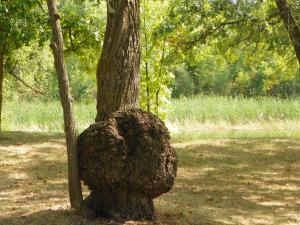
Tree
A Shady Oak with Junk in the Trunk
Mooned
| Author Notes |
I just couldn't resist this one.
My photograph. Taken September 2012 at Big Bog State Park, Red Lake, Minnesota. Mooned - American slang for dropping the trousers and flashing the buttocks, usually at a crowd. When both cheeks are large and fully exposed, it's called a full moon. Blushing allowed. Junk in the Trunk - Black American slang for having a large posterior. I guess the Bog wasn't the only thing that was big! |
![]()
By Treischel

Hey baby! Look at me!
Aren't I a lovely willow tree!
I think I'm pretty sexy!
How many trees can lay like this?
Come on over!... Give me a kiss!
I'll treat you to some woody bliss!
I'm out here on this beach,
So my bark can bray a sultry speech,
To bring you within my reach.
Here I am, right by the sand!
Green pom-pom in my pretty hand!
I think I look so very grand!
Don't you just love my shaggy top!
You think i'm easy? OH Stop!!
Before I call a cop!
| Author Notes |
Just a little nonsense.
I took this picture of a willow tree at Lake Phalen in St. Paul, Minnesota in August of 2012. Such an unusual tree. It reminded me of a model posing. It even has a belly button. So, this poem was always waiting to come out. It finally did today as I was going through my photographs. It will become one of my Animated Stills collection. Animated stills are poems where inanimate objects take on human, animal, or spirit forms, traits, or articles. They are derived from Photographs I have taken, that have moved me to write a poem associated with it. This poem exists only because of this photograph that tickled my Muse. |
![]()
By Treischel

One day
While walking
In the local park,
Past dark
I saw
A strange shape
That shouldn't be,
Under tree
Hidden
And quite stark,
Really blending
With bark
I took
Two passes,
When I found some
Glasses
Giant
Just must have
Dropped them there,
I swear
Very
Long ago,
In the cold snow,
You know
They're big
As branches
On Maple tree,
You see
Glasses
This huge size
Are very rare.
Don't stare!
Let them
Stay right there.
Someone's needing
A pair.
| Author Notes |
Just a bit a Nonsense
I was out on a walk, when I spotted these vines that reminded me of a giant pair of glasses. So I took a picture. My wife asked me, "Why are you taking a picture of that?". I replied, "Because it's interesting". I took the photograph in February 2012 along a path in the lower end of Battle Creek, just before it feeds into the Mississippi River in Minnesota about 5 miles South of St. Paul. This will become part of my Animated Stills collection. This poem is made with a syllable count of 2-3-4-2 Rhyme scheme between Stanzas is: abacdebff Rhyme scheme with stanzas is abcc abcc abcb abcb abcc abbb abcc abcc Animated stills are poems where inanimate objects take on human, animal, or spirit forms, traits, or articles. They are derived from Photographs I have taken, that have moved me to write a poem associated with it. |
![]()
By Treischel

Ghostly Winter Ball
The Ghostly choir sings, while gathered at the falls,
Seeking resonance as in those symphonic halls,
Drawn by the merry music of the water's sound.
A waterfall's clear tone is Nature's best around,
When eerie haunted tunes echo off frozen walls.
They gathered there to practice for their fancy Balls.
Soon phantom sounds are followed by their spectral calls,
While lady fairies gaily dance around the mound,
The Ghostly choir sings.
Wild water really dances while the chorus drawls
To hip hop melody the mad maestro installs.
Just can't stop twinkling toes from tapping on the ground.
Chances advance as spirited devil's play abound.
Moonglow shines brightly, as a magic mood recalls,
The Ghostly choir sings.
| Author Notes |
This is a poem motivated by my Muse upon seeing the image of the ice formation on the left side of the waterfall, that looked to me like a choir of Ghosts. So here is the result of that inspiration. Hope you enjoy it.
This poem is formated as a Rondeau Poem. It is my first attempt at this style. A rondeau is a fixed form of poetry. It is often used in light or witty poems. It often has fifteen octo - or decasyllabic lines with three stanzas. It usually only has two rhymes used in the poem. A word or words from the first part of the first line are used as a refrain ending the second and third stanzas. The rhyme scheme is aabba aabR aabbaR. In this one I used a beat of 12 counts, except for the refrain. I hope I succeded in meeting the requirements. Because ice is an inanimate object, and ghosts are not, this becomes part of my Animated Stills collection. This photograph is of Minnehaha Falls in Minneapolis, Minnesota taken in March 2012 near sunset using a Kodak 981Z digital camera. |
![]()
By Treischel

Maiden in the Ice
Legend tells the story,
The Maiden in the ice.
She met a frozen fate.
Took a risk, paid the price.
Superior's winters
Can freeze up Thunder Bay.
Save a lot of travel
By crossing it, some say.
Much to her sad regret
Maiden took bad advice,
Started walking one day
Across the frozen ice.
Fell right through a thin spot
And came out soaking wet.
Then climbed upon a ledge.
A place where fate was met.
Superior's howling winds
Stiffened up sodden clothes.
Image now forever
Remains right where she froze.
| Author Notes |
A Story I made up, based on the Image
Syllable count 6, Alternale line rhyming, abcb. I was up at Duluth, Minnesota showing a couple of my photographs at an art exhibit. While there, I drove up Lake Superior's North Shore a few miles to shoot some ice pictures. This in one of many I took. The image looked to me like someone frozen on a ledge. I just had to write a poem about it. So, here it is. This will become one of my stories in my Amimated Stills Poetry Book. Animated stills are poems where inanimate objects take on human, animal, or spirit forms, traits, or articles. They are derived from Photographs I have taken, that have moved me to write a poem associated with it. This picture was taken March 2, 2013 near the Clearwater Grille at Cape Superior. |
![]()
By Treischel

Gogli-eyed Love
(A Susnika Poem)
What's this as I alight?
Love, gogli-eyed!
Churned up inside
By the fireside.
Maybe romance tonight?
Why am I gogli-eyed?
I'm at a loss,
As my eyes cross,
Then turn and toss.
My love can't be denied!
| Author Notes |
Even insects find love.
This poem is a Susnika, two actually. A SUSNIKA exploring human emotions. It is a fusion form of Tanka and Nanni poems, just like an Acronet or Quonac but with a twist. A SUSNIKA is a five liner poem like a Tanka and with a 24 syllable count like a nanni, but with a twist (nassus1957 modified version) of the fixed syllable count of Tanka 5/7/5/7/7 into 6/4/4/4/6 syllable count instead. The first and last lines are rhymed but the remaining lines with 4 syllable count are unrhymed, although, I chose to rhyme them. This picture is of a dragonfly that I photographed this weekend, 7/20/2013 at my campsite at Lake Elmo, |
![]()
By Treischel
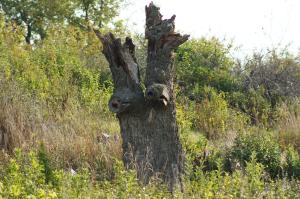
Woodland Watcher
(Mixed Formats)
<->
Little woodland sprite
is watching both day and night
security's tight
--<<->>--
What watched in the woods,
from fields of this land,
dismissed where it stood,
stump silently stands,
feet fixed in the sand.
Its bark doesn't bite.
Might be surprised,
you'll be in sight
of bulging eyes.
To obey
Nature's way
many say,
when spied
outside,
hide.
--<<->>--
This spirit of tree
Can't easily flee.
When safety applies,
It closes its eyes.
<->
| Author Notes |
Nature often comes up with some interesting shapes. Like this tree stump I spotted, in Blue Mounds State Park of Southwestern Minnesota, that looks like a little tree creature with bulging eyes. Naturally it tickled my Muse with the following result. It will become one of my Animated Still collection. Animated stills are poems where inanimate objects take on human, animal, or spirit forms, traits, or articles. They are derived from Photographs I have taken, that have moved me to write a poem associated with it.
This poem is comprised of 3 distinct poetic formats: a 5-7-5, a Diminishing Hexaverse, and a closing ABAB Rhymed Quatrain used as an envoi. A 5-7-5 Poem is simple a poem where line one has 5 syllables, line two has 7 syllables, and line three has 5 syllables again. It need not rhyme, but I chose to mono-rhyme it. A Diminishing Hexaverse is a poem that begins with a five-line stanza of five syllables in each line, then a four-line stanza with four syllables each, and so on, until the last one syllable stanza ends the poem. The reducing line and syllable count is why the form is referred to as "diminishing." The term "Hexaverse" does not refer to syllable count as much as it does with a "Hex" or "spell" that causes the syllables to disappear with each new stanza. Thus, "poof" it's gone. ABAB Rhymed Quatrain. I chose a tight 5 syllable count Quatrain (4 lined stanza) with an abab rhyming scheme to close the poem. This photograph was taken by the author himself. |
![]()
By Treischel

My Forest Friend
(A Retourne Poem)
What creatures hide betwixt the wood,
Doth lurk in hidden crooks of trees?
Strange looks make them misunderstood -
Their gentle personalities.
Doth lurk in hidden crooks of trees,
Too shy to make true presence known,
There're few more bashful sprites than these.
Quite frequently they're all alone.
Strange looks make them misunderstood.
'Tis due to their misshapen head,
Whose eyes portray death's likelihood,
And howling maw, cause fear and dread.
Their gentle personalities,
Beknownst to me, I shall defend,
And offer friendly dignities,
When e'er I spot my forest friend.
| Author Notes |
I like to spot things that look strange and create a story poem about them. This is just a broken tree limb in the forest, but I see a spooky looking face of a howling forest spirit. So, it inspired this poem. It will become one of my Animated Stills Poetry collection. Animated stills are poems where inanimate objects take on human, animal, or spirit forms, traits, or articles. They are derived from Photographs I have taken, that have moved me to write a poem associated with it.
This poem is formatted as a Retourne. I discovered this while reviewing Denhagan's poem, My Troubled Heart. The Retourne poem is another French poem style. Like the Quatern, the Retourne poem has four quatrains (four-line stanzas), and each line has eight syllables. Also, like the Quatern, the Retourne poem does not have to rhyme. The Retourne poem uses the second, third, and fourth lines of the first stanza as Refrain lines for the first line of the following three stanzas: line two of the first stanza becomes line one of the second stanza, line three becomes line one of the third stanza, and line four becomes line one of the fourth (and last) stanza. Even though they do not have to rhyme or follow a specific meter, I have chosen to write this Retourne poem in iambic tetrameter with a rhyme scheme of: a1,B1,A2,B2 B1,c,b,c A2,d,a,d B2,e,b,e where the first and third lines of each stanza rhyme and where the second and fourth lines of each stanza rhyme, and B1,A2,and B2 represent the Refrains from the first lines in the poem. This photograph was taken by the author in the woods at Maplewood Preserve in St. Paul, Minnesota on a snowy day in February, 2011. |
![]()
By Treischel

Are snow monsters real
with sharp
crystal teeth
devouring roof tops
in gigantic gulps?
Oh woe!
What to think,
when
the unsuspecting,
all very warm and cozy,
drinking their hot chocolate
and snuggled under thick quilts,
have
their
rafters
come
tumbling
down?
Remember
those
small round
remorseless eyes
that hunger for a tasty treat.
No structure is safe
From the icy fangs.
They'll crunch
Both bed and bones!
Are you safe in your house
from the freezing crush?
Beware!
| Author Notes |
This image reminded me of a large bird-like snow monster biting a house roof. Maybe my imagination has run away a bit.
An animated still is a still-life photographic image that takes on a life-like aspect that inspires a poem. Author photograph. |
![]()
By Treischel

Ole Blue
You've heard the tales of Paul Bunyan
And Babe, his big blue ox.
He also had a big puppy
That grew big as a house.
The puppy was a Saint Bernard
With paws bigger than most
Seen around Lake Superior
Swimming in that big Lake
Now Paul really loved that doggy.
One day while he was about,
Watched it floating in cold water,
He named that doggy Blue.
You probably would have too!
That lake's as cold as the arctic,
With winds that blow huge waves.
A cold cruel death is awaiting
For sinking sailormen.
Once when the winds of November
Sunk a ship off the shore.
Ole Blue dove into the water
Saving the entire crew
What a wonderful thing to do!
If you ever see his white head
Around the old ice caves
It just might be Old Blue out swimming
Someday he might save you.
Then you'll know this story is true!
| Author Notes |
Growing up in Minnesota, I heard lots of tall Lumberjack tales about that giant, Paul Bunyon and Babe the Blue OX. When I took this photograph up in Duluth along Lake Superior, the icy rock on the right looked to me like a big dog swimming in the water. So, I thought I'd add a chapter of my own ( after all, I am a Minnesotan, born and bred), to the legends. So, I created another companion for Paul and Babe - Blue, the Saint Bernard. Hope you enjoyed it.
This is a free verse poem with some incidental rhyme. The photograph that inspired this poem was taken on 3/2/2013 at Stony Point along the North Shore of Lake Superior. It is a still life that looks animated. It will become part of my Animated Stills Poetry Book. |
![]()
By Treischel

Alien Skull
(A Whitney)
Big surprise,
alien skull.
Secret eyes
are fairly dull.
Hard to spot
this hidden hull.
Why was it left there to rot?
| Author Notes |
Using a bit of imagination, I see an alien skull here. You'll have to look hard for the eye sockets, then it comes together with a straight line mouth at the bottom.
This poem is a Whitney. The Whitney poem format was created by Betty Ann Whitney. This is a seven-line versed poem based on Japanese patterns with a fixed syllable format that contains 3, 4, 3, 4, 3, 4, 7 syllables respectively. No rhyme scheme is required, but may be incorporated if desired. For this poem I did use a rhyme scheme. It is: ababcbc. This photograph was taken by the author himself, of a snowy tree branch in his back yard. It will become one of my Animated Stills collection. Animated stills are poems where inanimate objects take on human, animal, or spirit forms, traits, or articles. They are derived from Photographs I have taken, that have moved me to write a poem associated with it. |
![]()
By Treischel

The Gnome
(A limerick)
I came upon a sight not far from home
A rock that looked just like a gnome
A chubby little face
In most unusual place
Could not discern - grimace from a groan.
| Author Notes |
I see a face with chubby cheeks and a bent hat looking out of this rock. Maybe I have too wild an imagination. If you don't see it, imagine that the long crack across the front as eyebrows. and that the trapezoid impression, as a mouth area with just the hint of lips inside. Just above it is a dot of a button nose. If you see that, then you should see the hair line and the toppled hat. Chubby cheeks. Almost a Santa. Is he squinting or frowning? Oh well, just having fun.
This poem is a limerick. It has the usual aabba rhyme scheme, and syllable count of 9/9/6/6/9. This photograph was taken by the author. It is one of his Animated Stills. Animated stills are poems where inanimate objects take on human, animal, or spirit forms, traits, or articles. They are derived from Photographs I have taken, that have moved me to write a poem associated with it. When I write enough, I'll publish a book of them. |
![]()
By Treischel

Little Bo Peep lost her sheep,
But I think that I have found him
Buried deep and fast asleep
In the forest, much like a tree limb.
She left him alone. He never came home.
His survival was looking dim.
So, Little Bo Peep had only to weep
When he entered that tree on a whim.
Poor little lamb was caught in a jamb
When the bark enclosed around him.
Forevermore, he's part of the lore
In the tales of the Brothers Grimm.
| Author Notes |
I spotted this tree trunk deep in the woods. The imperfections in the bark reminded me of a lamb or a bunny stuck in the tree. So I wrote this little poem that adds to the Little Bo Peep Fairy Tale.
This Poem is an Animated Still. Animated stills are poems where inanimate objects take on human, animal, or spirit forms, traits, or articles. They are derived from Photographs I have taken, that have moved me to write a poem associated with it. I am compiling a book of these type of poems. I currently have 28 of them collected. |
![]()
By Treischel

An angry spirit lingers in the rock
Imprisoned there since long forgotten time.
To some it seems a simple sandstone block
That's coated with some centuries of grime,
A guardian where people often climb.
Although the effort's difficult and steep,
Because the views up there are so sublime,
You share them with the likes of Bighorn Sheep.
Beware! As there are secrets those stones keep.
You're being watched by wizard's evil eye,
With stare whose glare may make your neck skin creep.
It's said that spirit has caused some to die.
So, if you don't respect that sacred ground,
It may be you'll no longer be around.
| Author Notes |
This is a sandstone outcrop on a cliff know as Dayton's Bluff near downtown St. Paul, Minnesota. I saw in it a very distinguishable eye and somewhat of a face. That inspired me to write this poem which will become part of my Animated Stills collection. Animated stills are poems where inanimate objects take on human, animal, or spirit forms, traits, or articles. They are derived from photographs I have taken, that have moved me to write a poem associated with it.
This poem is a Spenserian Sonnet. The Spenserian sonnet, was invented by Edmund Spenser as an outgrowth of the stanza pattern he used in his poem, The Faerie Queene (a b a b b c b c c),that has the pattern: a b a b b c b c c d c d e e Here, the "abab" pattern sets up distinct four-line groups, each of which develops a specific idea; however, the overlapping a, b, c, and d rhymes form the first 12 lines into a single unit with a separated final couplet. The three quatrains then develop three distinct, but closely related ideas, with a different idea (or commentary) in the couplet. Interestingly, Spenser often begins L9 of his Sonnets with "But" or "Yet," indicating a volta, exactly where it would occur in the Italian Sonnet; however, if one looks closely, one often finds that the "turn" here really isn't one at all, that the actual turn occurs where the rhyme pattern changes, with the couplet, thus giving a 12 and 2 line pattern very different from the Italian 8 and 6 line pattern. A Spenserian sonnet does not appear to require that the initial octave set up a problem that the closing sestet answers, as with a Petrarchan sonnet. Instead, the form is treated as three quatrains connected by the interlocking rhyme scheme and closed by a couplet. The linked rhymes of his quatrains suggest the linked rhymes of such Italian forms as terza rima. This picture was taken by the author himself on March 28, 2015. |
![]()
By Treischel

Spirit of the summer flowers,
Hidden there in the brightest blooms,
Elfin King with mystic powers
Concealed in camouflage costume.
I see your impish beaming grin.
Your eyes and beard give you away.
What secrets do you hide within
That colorful arranged bouquet?
Knowing you can grant some wishes,
And I've caught you hiding there,
Will you deign to grant some riches,
Or disappear into thin air?
| Author Notes |
The little spirits hide in plain sight. Look closely and you'll spot them. Look at the white flower in the lower left corner.
ABAB rhymed quatrains on a mixed 8 syllable meter. This poem is an Animated Still. Animated stills are poems where inanimate objects take on human, animal, or spirit forms, traits, or articles. They are derived from Photographs I have taken, that have moved me to write a poem associated with it. They require a close look at the photograph, and some imagination, to spot them. It will become one of my Animated Stills collection. This photograph was taken by the author himself on July 11, 2015 at his brother, Richard's, Anniversary party. |
![]()
By Treischel
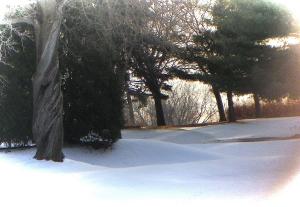
The Demon's Hand is on the land,
and won't let go.
He knows that we don't understand.
So things that grow
are in his grasp, 'cause we forgot
our roles are to not let it rot.
He's moving in to run the show,
and won't let go.
The Demon's Hand is taking Earth,
and soon we'll know
too late, to not ignore its worth.
For long ago,
He promised that he would take it,
if we humans failed to make it.
He's got control, to our great woe,
and won't let go.
| Author Notes |
So beware! If we don't take care of our planet, Satan will take it over. The signs are already there.
I saw this tree and it reminded me of a deformed hand reaching out of the ground to grasp it. That became the inspiration for this poem. So it is an ekphrastic poem. It will also become one of my Animated Stills. So this poem is an Ekphrastic Octogram/Animated Still. Ekphrastic is a poem that is written based on the attached image. So, the image came first and was the inspiration. The Octogram is a style of poetry invented by Fanstorian Sally Yocom (S.Yocom). It consists of two stanzas of eight lines each, with a very specific syllable count and rhyme scheme. Syllable count is 84848884, repeat on second stanza. Rhyme scheme: aBabccbB ababddbB, where B repeats same text. No more than 16 lines. The tempo is tetrameter on the 8 count line, and dimeter on the 4 count line, but not necessarily iambic. Animated Stills are poems where inanimate objects take on human, animal, or spirit forms, traits, or articles. They are derived from Photographs I have taken, that have moved me to write a poem associated with it. This photograph was taken by the author himself on January 30, 2012. |
![]()
By Treischel
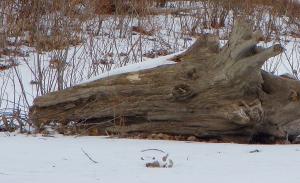
What residue lay on this shore?
What remnant shard of ancient lore?
I can't believe what's from the tide,
So evidently petrified.
Its presence there can't be denied,
Although I've never seen it there before.
You may perceive just jetsam junk,
Or driftwood from a rotted trunk,
But scientists will see the eye,
And wood, where bones decalcify,
A rakish ridge with horns nearby,
And even spots where scales were countersunk.
I've read about them in a book,
Foreboding creatures time forsook.
Has it lain hidden in the snow?
This head from myths of long ago,
Through only legends do we know?
Yet evidence here seen can't be mistook.
It surely is a Dragon's head,
Once severed and completely dead.
Did mighty sword from heaven's forge,
In noble hands of good St. George,
Behead this beast to now disgorge
Like refuse on this beach, just steps ahead?
| Author Notes |
This is an Animated Still of a driftwood tree trunk that reminds me of a Dragon's skull. I came across it along the Mississippi River. Dragon's bring to mind the legend of St. George. Since George is my middle name, I have always been interested in him. So, I thought I'd share some of his story here. Given the current Syrian refugee crisis, I thought a story about a Syrian Christian martyr appropriate.
Saint George (AD 275 to303), according to legend, was a soldier in the Roman army who later became venerated as a Christian martyr. His father, Gerontius, was a Roman army official from Cappadocia and his mother, Polychronia, was a Christian from Lydda in the Roman province of Syria, Palestine. Saint George became an officer in the Roman army under Emperor Diocletian, who ordered his death for failing to recant his Christian faith. But before that, he became renowned for many heroic exploits. As part of the Golden Legend, a dragon makes its nest at the spring that provides water for the city of Lydda in the Holy Land. Consequently, the citizens have to dislodge the dragon from its nest for a time, to collect water. To do so, each day they offer the dragon a sheep, and if no sheep can be found, then a maiden becomes the best substitute. The victim is chosen by drawing lots. One day, this happens to be the princess. She is offered to the dragon, but then Saint George appears on his travels. He faces the dragon, protects himself with the sign of the Cross, slays the dragon, and rescues the princess. The citizens abandon their ancestral paganism and convert to Christianity. This poem is a Sestet. Sestets are poems with six lines per stanza. They come in many formats. For this one, I use a cadence of : 8,8,8,8,8,10 The rhyme scheme follows the pattern: aabbba in each, but does change the rhyme. It meter is iambic. This photgraph was taken by the author himself on January 28, 2012. |
![]()
By Treischel

A Great Designer touched this very rock,
Whose fingers chiseled patterns in the stone,
Way long before the concept of a clock,
Or even prior to a living bone.
This pattern spotted, caused a major shock,
Perceiving it was wrought by God alone.
For who but He could carve on granite block,
Then leave it here on Earth for us to own,
A rose within a stone.
His laser touch was seen just once before.
On hard slate tablets Heaven's words were hewn.
When Moses brought Commandments to the fore.
But he returned from mountain top too soon,
In anger, broke them all on valley's floor,
Then God replaced his words, next afternoon,
And hid them 'hind the tabernacle door.
Yet this stone's just as magic as a rune,
A rose within a stone.
For this is still a very special place.
A place where God's good work is everywhere.
He must have drawn some plans within this space.
The evidence is scattered here and there.
The work of His creation's left a trace,
Of little sketches meant to help compare
From which new pretty pattern to embrace.
To find a blueprint, still, is very rare,
A rose within a stone.
| Author Notes |
If you look at the top of this rock, there is an indentation that looks like the flower of a Rose. I hope you can see it. If you do, you might also see the hint of a stem, maybe even some petals. This is the image that inspired my poem to go on a flight of fancy. It will become part of my Animated Stills collection.
This poem is written in Octaves, or Octrains (8 Lines stanzas), with a repeated refrain. The rhyme scheme uses alternating rhymes, or: ababababR. Except for the refrains, the meter is iambic pentameter. An Animated Still are poems where inanimate objects take on human, animal, plant or spirit forms, traits, or articles. They are derived from Photographs I have taken, that have moved me to write a poem associated with it. This photograph was taken by the Author himself at the Japanese garden in Como Park of St. Paul, Minnesota on September 10, 2013. |
![]()
By Treischel

These chilly canyons strange companions hide, to my surprise.
I hear the cackle hidden in the crackle of the ice,
And I despise that feel of eyes my senses realize.
The ghosts are there, must be somewhere, I felt it once or twice.
Behind each boulder, eyes upon my shoulder, are so vague.
But will he show, this man of snow, who's hidden in the wall?
It seems he blends where ice suspends from every little crag.
What I can't see, I want to flee. I don't like this at all!
Oh! There he is, that mug of his, I see him hiding there.
His hollow eyes can't be disguised, so large they point him out.
That toothless mouth was facing south. I really didn't care
To see him there, up in the air, just hanging all about.
I see now other ghosts among those frozen posts, but you,
Whose voice annoys with creepy noise, continue showing through.
| Author Notes |
If you look for a circular eye in the middle right side of this photograph that I took of a hanging ice formation, you might see the toothless face that I'm referring to in this Animated Still poem. If you have a very active imagination, you might see some others. I see a phantom above and to the left, with a frozen arm pointing downward. I took that as the direction to the south that I referred to. Then there is a small head to the far left. I hope your imagination can make something out.
This is an Animated Still. Animated Stills are poems where inanimate objects take on human, animal, plant or spirit forms, traits, or articles. They are derived from Photographs I have taken, that have moved me to write a poem associated with it. I am collecting a book of them. This photograph was taken by the author himself on January 23, 2016 at Minnehaha Falls Park in Minneapolis, Minnesota. |
![]()
By Treischel
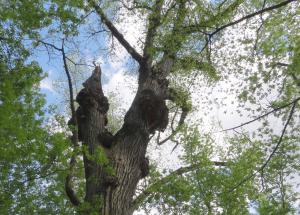
I thought I saw a bear up there,
right at the apex of the tree.
I really couldn't help but stare.
I thought I saw a bear up there,
and it was clinging tight, with care.
But no, it's just a burl I see.
I thought I saw a bear up there,
right at the apex of the tree.
| Author Notes |
When I was out walking on Pike's Island, an island in the Mississippi River just below Fort Snelling, I thought I spotted a black bear up in a tree. It surprised me for a moment, until I realized that it was just a burl. Zebulon Pike camped on this island in 1805 during his expedition after the Lousianna Purchase that resulted in the naming of Pike's Peak in Colorado.
A burl is a growth on a tree. Sources suggest that a burl could be caused by many environmental factors. To be sure, burls and galls may serve as secondary infection avenues for insects and diseases, but as a rule they do not appear to be harmful to most trees and maintain a protective bark around the area where the burl occurs. They look like bumps or warty growths probably caused as a result of some environmental injury. Whatever the irritation, it stimulates a protective growth as a defense mechanism. Burls can yield a very peculiar and highly figured wood, one prized for its beauty by many and sought after by people such as furniture makers, artists, and wood sculptors. This poem is a Triolet. A Triolet is a French repeating poem of only eight lines, and often all lines are in iambic tetrameter. It contains only 2 rhymes, with a rhyme scheme of: ABaAabAB. The fourth and seventh lines are the same exact line as the first (see capital As). The eighth line is the same exact line as the second (see capital Bs). Because five of the eight lines repeat, this is one of the easiest French formats to create, yet when the repeated lines are chosen well, it creates a lovely poem. The poem will become one of my Animated Stills collection. Animated stills are poems where inanimate objects take on human, animal, or spirit forms, traits, or articles. They are derived from Photographs I have taken, that have moved me to write a poem associated with it. They require a close look at the photograph, and some imagination, to spot them. This photograph was taken by the author himself on May 1, 2016. |
![]()
By Treischel
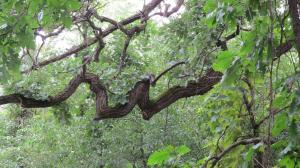
I never knew
A tree could spell,
But here's the tale
That I can tell.
When I was out,
Just passing through,
I saw one form
A "W."
I'm not sure what
It meant to say.
Maybe it meant
To say, "This Way."
Or, maybe it
Was doing best
To show the way
Of going West.
It even might
Be saying "Woah!"
Is danger here?
I just don't know.
I'm sure that it
Was meaning well.
I never knew
A tree could spell.
| Author Notes |
This tree branch certainly looks like a W to me. It inspired this poem. I wrote it in iambic Dimeter with an abcb rhyme scheme.
This poem is an Animated Still. Animated stills are poems where inanimate objects take on human, animal, or spirit forms, traits, or articles. They are derived from Photographs I have taken, that have moved me to write a poem associated with it. This photograph was taken by the author himself on Auguxst 18, 2016 |
![]()
By Treischel

This staff became a snake before my eyes!
It garnered instant dread
while hung above my head
in forest where I tread,
and one can just imagine my surprise.
I know not how it got up there,
This serpent hanging in the air.
My instincts told me to beware!
Is this the Evil One who tempted EVE with lies?
With God's forbidden fruit, did he deceive, disguise?
As I recall old Moses had a staff
that turned into a serpent
when thrown upon the ground
in front of Egypt's Pharaoh.
This staff became a snake before my eyes!
But now I see it's just a branch of wood,
a serpentine display misunderstood.
Be still my heart, there's nothing here to fear!
Its origin is now completely clear.
No staff became a snake before my eyes!
'Twas just a figment caught me by surprise.
| Author Notes |
I actually did come across this wooden branch during one of my walks in the woods, and it did startle me for a minute. It is only a wooded vine, but it sure looked like a snake for a moment. Of course, I was inspired to capture its image and write this poem. it will become one of my animated stills.
The poem is a Fusion Sonnet. This falls under the auspices of the Modern Sonnet genre. As such, it breaks several Sonnet rules. Most notably, it has 21 Lines rather than the typical 14. The Fusion comes from blending in 4 lines of Free Verse at lines 11 through 14. It has a strict Structure and Rhyme Scheme, but is more flexible in the area of Meter. Here are the complex rules: 14 line Poem followed by a Half Sonnet of 7 lines acting as a Coda or Tail to add additional stability to the poem. No particular Meter is followed, "Fusing" it with the modern Free Verse style. First Fourteen Lines: Same Rhyme in 1st,5th,9th & 10th Lines. Same Rhyme in 2nd,3rd & 4th Lines. Same Rhyme in 6th,7th & 8th lines. Rhetorical questions in 9th & 10th lines. Negative and pessimistic note in the first 10 lines. Free Verse in 11th, 12th,13 & 14th Lines. Line 15 repeats line 1. Next Seven Lines:-The Half Sonnet acting as a Coda. Same Rhyme in 16th and 17th lines. Same Rhyme in 18th and 19th lines. Line 19 and 20 repeats line 1 and 5. ( I modified them slightly here.) This picture was taken by the author himself on July 11, 2017 at Battle Creek Park in Maplewood Minnesota. |
![]()
By Treischel
With darkness drawing near in shadows, fears recalled
what Giants roamed these woods in days gone by.
I felt like I was being watched!
My senses burned, felt tracked by evil eye,
all while my racing heart was stalled, my skin soon crawled.
For there, beyond the turn, was spied large lurking form.
It seemed to be alive, like vigil guard.
I felt like I was being watched,
by something much too large to disregard --
this shaded silent presence, far beyond the norm.
Most disconcerting here, was shape's enormous size --
a house-size helmet, shading eyes widespread.
I felt like I was being watched,
by something like Goliath's severed head.
The eyeballs blinked, to my most mortified surprise.
Was rendered witless by this object on the ground.
The Book of Enoch said some "Watchers" came.
I felt like I was being watched!
This silent giant, possibly the same,
just may be ancient angel that is still around.
I felt like I was being watched!
| Author Notes |
I hope that you see the image here of a rock that looks to me like a helmeted head, inspiring this poem. If you see the eye sockets, then you can make out the nose and bearded face just peeking over a berm. What looks like a shining eye is actually just a weed bending in front of the stone. I am working on my next book, Animated Stills, for 2018. This will be one of them. I blended in the Story of the Watchers and Goliath. Besides the Book of Enoch, the Watchers are mentioned in the Bible in the story of Noah. Many ancient cultures mention the giants that once existed.
This poem is a Symmetrina. The Symmetrina was created by Fanstorian Pantygynt. I discovered it while reviewing his poem, Polhena Beach, Sri Lanka, 0600. It is called a Symmetrina because it presents a symmetrical shape and rhyme scheme over each stanza: The rhyme scheme for each is: abcba. The rhythm is iambic throughout. It is structured in Quintets, which are stanzas with 5 lines. The first and last lines are Alexandrine Hexameters (12 syllables), the second and fourth pentameters (10 syllables) and the third is a tetrameter (8 syllables). So the meter becomes: 12,10,8,10,12. Note how the rhyme scheme rises (a,b,c), then falls, while the meter falls (12,10,8), then rises. No limit to the number of stanzas. For this poem I modified the rhyme scheme a bit. I used the middle unrhymed line "c" in the middle of the stanza as an interlinked, repeating line in every stanza. I also used the "c" line as the closing envoy to give a somewhat unique overall rhyme scheme that looks like this: abCba - deCed - fgCgf - hiCih - C. This picture was taken by the author himself in June 2016. |
![]()
By Treischel

The lizard slithered through the slime,
arising from the mists of time,
to wallow in the iridescent muck.
What, to my unfortunate luck,
did fortune let laboriously climb
just moments from my feet?
I must retreat!
For fear had gripped my very soul,
and from my wits, taken its toll.
But wait! I now perceive, it's just a branch!
From this tree bough, I need not blanch.
My nerves have now regained complete control.
The likenesses' deceit
sent me offbeat.
| Author Notes |
Hah! I was out walking along a swamp platform located at the Dodge Nature Center in Mendota Heights, Minnesota, when I came across this object in the water. It sure looked like an alligator. Of course, there are no alligators in Minnesota. It's too cold in the winter for them to survive. So I was a bit surprised, until I realized that it was only a tree branch. I took this picture and wrote this poem for my Animate Stills Collection.
The Poem is a set of Septets Septets are poems with 7 line stanzas. Not an established format, that I am aware of. Just something I put together. I was playing a bit with line lengths, so the syllable pattern is: 8,8,10,8,10,6,4 and 8,8,10,8,10,6,4. The rhyme scheme is: a,a,b,b,a,c,c d,d,e,e,d,a,a. This photograph was taken by the author himself, using just his cell phone, on October 8, 2017. |
![]()
By Treischel
.jpg)
The Torah tells of Moses' death
with "Al pi Adonai."
As he was breathing his last breath,
God kissed him from on high.
He never touched the Promised Land,
still he was dearly loved.
For there upon the Sinai sand,
God kissed him from above.
Observers are all awed.
The angels all applaud,
the Kiss of God.
Imagine the clouds gathering,
as scarlet face protrudes
from purple nimbus, capturing
a Godly attitude.
The regal cloud then hovers low
containing loving lips
that reached down to the man below,
emotions to eclipse.
Observers are all awed.
The angels all applaud,
the Kiss of God.
This was a noted incident,
when God was in this state,
but not the only precedent
receiving Godly fate.
God often kisses things He loves,
those things of greatest worth.
His way of showing He approves.
He even kisses earth!
Observers are all awed.
The angels all applaud,
the Kiss of God.
| Author Notes |
The sky was awesome the other day, and I took a picture of it with my cell phone from a parking lot at a store where I was Christmas shopping. In looking at it later, I noticed, just to the left of center, what looked like lips. Above them you can make out the semblance of a nose and eyes - a face in the sky! I said to myself -"This would make a wonderful Animated Still." But I needed a Muse. So I searched the internet for a story about a face in the sky, and was delighted to come across the story of Moses. Here's how The Talmud describes it.
In a Blog by Rabbi Brant Rosen, I read: "Readers of the Torah often comment on the seeming unfairness of God's decree that Moses must die before he can enter the Promised Land. But when we reach the final verses of the Torah, the tone feels anything but untimely or tragic. Rather, God's treatment of Moses in his final moments hints at a spirit of love and tenderness." "Commentators have made much of the words "al pi adonai - "at the command of the Lord," which literally means "at the mouth of the Lord." In the midrashic imagination, this verse is commonly read: "Moses died-at the kiss of God." Some have pointed out the poignant symmetry of this image: just as God breathes life into the first human, God reclaims Moses' soul through a similar loving act." I tried to capture the gist of of that story, while accommodating my image as well. I also blended in the thought of a similar love for the Earth. God's kiss as rain. This poem is a simple Ballad, using the signature 8-6 tempo, an abab rhyme scheme, and a 3 line repeated chorus, having a 6,6,4 mono-rhymed meter. This photograph was taken by the author himself on 11/26/2017. |
![]()
By Treischel
The Crane and Crab, a tale about turned trust!
Old wily crane, at pond he stood beside
attracts a crab, who asked him why he cried.
The crane heard words two anglers did decide,
to drain the pool to get the fish, they must.
The tale goes on as crab gets fish concerned.
The Crane and Crab, a tale about turned trust,
proposes perfect plan where fates adjust,
if on crane's wings, for transfer, they entrust.
Then angler's methods can be swiftly spurned.
The fish agreed to be flown far away.
So one-by-one the foolish fish were rushed.
The Crane and Crab, a tale about turned trust,
as crane nearby fulfilled his hunger lust,
consuming many in a single day.
The crab requested to be taken too!
At this, the greedy crane became nonplussed,
as crab crawled on and grabbed a feathered tuft.
The Crane and Crab, a tale about turned trust
took to the air, observing carnage view.
Then angry crab claws into crane's neck thrust.
"I'll cut your neck if you don't land," crab said.
"Please spare me, it was only fish are dead."
"OK," said crab. When down, snapped off his head.
The Crane and Crab, a tale about turned trust.
| Author Notes |
In this picture of two trees, I saw two images. In the first tree, I see what resembles a crab. In the the other tree, I see what looks like some bird, with a long sharp beak at an angle about 7 o'clock, and tall green headfeathers. I hope you can see that too! This is what inspired this story poem about a crane and crab, for my Animated Stills collection.
This tale is told in many versions, different details, and several languages. I just captured the gist of it here. If you google it, there are several books written. The oldest known writing comes from the Panchatantra, which is an ancient Indian collection of interrelated animal fables in Sanskrit verse and prose. Aesop, the Greek storyteller, told a similar story only the bird is a heron, and the fishermen went to get their nets. This poem is a Quinquerne. The Quinquerne is a creation of our own Fanstorian, Pantygynt. It uses ten syllables per line of iambic pentameter. The Quinquerne, as its name suggests, works in multiples of five - five Quintrains of enveloping rhyme (two around three), with the first line, repeated as a refrain line cascading line by line through each Quintrain. The rhyme scheme which, unlike the Quaterne, is essential with this form, as the "a" rhyme is repeated 12 times within the 25 lines. Also, the format of the refrain is critical to the flow and transitions. The rhyme scheme is: Abbba, cAaac, daAad, eaaAe, afffA, where the capital letter indicates the repeated line. Feminine endings may be employed, but would not, however, be stipulated as a requirement of the form. For this poem, the refrain was a bit stilted, but I felt the format was essential, as each stanza provides a different twist on trust, justifying its reassertion. In stanza one, the crab trusts the crane's story. In stanza two, the fish, crab, and crane all trust in the plan. In stanza three, the fish all trust in the honesty of the crane not to harm them. In stanza four, the misplaced trust is revealed. Finally, in stanza five, the crane trusts the crab not to harm him. So, this story has many angles that ripple through it. This picture was taken by the author himself on October 23, 2016. |
![]()
By Treischel
When you think of a typical forest,
and its woodlands, and rivers, and hills,
do they dance and resound in a chorus?
Do they tap to the tune of foothills?
Well I once found a magical meadow,
with the trees and the brush on parade!
All the birds, and the squirrels, in the shadows,
were engaged in a gay masquerade.
In the forest the wildlife were dancing
to the breezes that blew merry tunes.
The warm air was soon full of romancing.
Branches swayed to the sounds of the loon.
When the music pulsates through the jackpine,
all the elves then perform happy tasks,
like each serving up goblets of sweet wine.
There were even tall trees wearing masks.
Even tall trees wearing masks!
| Author Notes |
How's that for a poem to accompany this image for my Animated Stills collection? To me, this looks just like a mask on a tree. Maybe it's a stretch, but enough for me to inspire this poem about a masquerade. I thought I'd turn this dreary image into something joyous and active. It hope you come away with a festive feeling.
Please note that here, I pronounce the word "Squirrel" in the Americanized vernacular as being a 1 syllable word as in "skewrl." This poem is simply a set of abab rhymed quatrains. I added a one line envoy to reinforce the subject of my image. It is written in anapestic meter. To me, this anapestic meter is like waltz, rather than the march of iambic meter. It is a more graceful - da da dum da da dum da da dum, as opposed to the other's da dum da dum da dum. For this poem I used interposed feminine and masculine rhymes, giving a syllable count of 10-9-10-9. This photograph was taken by the author himself on October 29, 2016. |
![]()
By Treischel
A fish appeared from arctic blue,
just like a ghost.
A phantom you could see right through!
I was engrossed
in this opaque new mystery,
without a well-known history.
Its presence seemed surreal, almost.
Just like a ghost.
I thought I'd try to capture it,
at my utmost.
Alas, the fish did not permit
a single dose
of any human interaction.
Creating stymied satisfaction,
by disappearing undermost.
Just like a ghost.
| Author Notes | Another of my Animated Stills. This is just some ice in a stream, but I thought there looked like a fish head in the lower left . |
![]()
By Treischel
There once was a small fox family
that lived in roots of large oak tree
nearby Medieval built Cathedral Town,
where they could watch the goings-on
at village church and graveyard, yon,
observing human tasks from dusk 'til dawn.
Renard was oldest, father fox.
His wife, Fiona's crimson locks,
were his most prized and cherished attribute,
but not more loved than their son Tod,
a playful boy, who would maraud
the local vineyard - Church's precious fruit.
This annoyed the Bishop!
Deprived of wine, the Bishop prayed,
like Solomon's similar raid,
"Lord, catch the foxes that ruin the vineyard."
With that some deadly traps were set,
where Tod was caught within a net.
Then killed by hunters. Body left to disregard.
Fiona was beside herself!
Renard had lost his mental health,
and these became the couple's darkest days.
But once they both regained their nerves,
determined their son's death deserves
to be respected, just like human ways.
This involved the Bishop.
Back in those days, a fox could talk.
Renard was soon induced to walk
to obtain a burial for his son
within the local cemetery,
complete with sacred ceremony.
As such befits a most beloved one.
The fox achieved an interview
with Bishop, firm in Pontiff's pew,
who said, "Dear friend, you must be too confused.
No foxes can be buried here!
The Catechism's words are clear --
Just humans, sacred grounds. Request refused!"
Thus invoked the Bishop.
Fiona and Renard were mad.
The situation very sad.
They put forth a magical inclination.
If humanity is required,
they had the means that were desired,
for foxes were well known for transformation.
Renard changed Tod into a boy.
Required further for this ploy
were artifacts of Christianity.
Such things were needed to be found
for access onto sacred ground.
Deception had become a certainty --
to hoodwink the Bishop
So into church the couple drew,
to search each corner, every pew,
and there they found a holy locket chain.
Then, in the village, out to dry,
a peasant's garments, foxes spy.
So into pocket, locket chain was lain.
Tod's body later, gotten dressed,
when found where roads crossed east and west,
was taken to the local undertaker.
No relatives at all respond.
Considered Christian vagabond.
Consigned to cemetery pauper's acre.
To be blessed by Bishop.
So, one fine morning, it was done.
To satisfy most everyone,
a small procession exited the church,
that carried a small wooden box.
Inside it was the transformed fox.
Unseen, its true identities emerge.
And on a tree nearby the site,
two foxes watch it with delight.
Tod buried with all proper dignity,
will hence be mourned with loving cries,
each evening as the twilight dies,
to echo now throughout eternity,
and heard by the Bishop.
| Author Notes |
I love to examine tree roots, and there are several along the Mississippi River banks. You never know what images they might reveal. This is one of my favorites. Doesn't it look just like a fox with a a long bushy tail? I shot this picture one day, mainly to show the juxtaposition with the Cathedral of Saint Paul, but didn't notice the fox until I loaded the image onto my ipad later. Then I was pleasantly surprised. It required a special poetic inspiration. So, I researched all the fox legends for a proper muse. The poem that resulted is my own creation, but I should explain some of its sources. It was written to become part of my Animated Stills collection, but I my also publish it as a separate children's book some day. I am certainly open to suggestions and/or corrections.
Many cultures have legends about foxes. They mostly describe them as cunning tricksters. The word "shenanigan" is from the Irish word "sionnachuighim", meaning "I play the fox." Of course, we've all heard of someone being "out foxed." Most legends have them talking. There are tales of fox transformation into humans. Celtic tradition, particularly Scottish, use the name "Tod" for fox. Meanwhile, there are several stories in literature about a fox named Renard. The name Fionia is attributed to the Scottish poet James Macpherson, author of the Ossian Poems, which he claimed were translations from ancient Gaelic sources. Fiona is derived from an element meaning "vine." Song of Solomon 2:15 - "Catch us the foxes, the little foxes that ruin the vineyards, our vineyards are in bloom." To a priest, much less a Bishop, what is more important than his wine? A Cathedral is the seat of a Bishop. So, all these elements coalesced to inspire my poem, but the concept is mine, due to the imagery. This poem is simply a series of sestets (six line stanzas) with a rhyme scheme in each of: aabccb. The basic syllable count is 8,8,10,8,8,10, and a recurring refrain of 6 after every second stanza. This photograph was taken by the author himself on March 6, 2016. |
![]()
By Treischel

There was a shy bird who said "Shoo,"
it wasn't a "Hoo", but a "Shoo."
Because he was shy,
and couldn't quite fly,
he would hide in the woods that he knew,
behind rocks and some trees,
one or two.
He was scared of the shadow he threw.
Which was when that his feathers turned blue.
And you knew, he would wish us adieu.
If you spot him, you'll hear "Shoo Shoo Shoo"
Shoo Shoo Shoo
Shoo Shoo Shoooo
You may never, have ever, have heard
of this timid and sneaky old bird
He is so very shy
I don't even know why
it really is simply absurd
He won't speak, if you please
Not a word
He is Sheldon the shy Shoo Shoo Bird
Not a peep, or a chirp, will be heard,
Not a cackle, or tweet, or a hoo.
Our Sheldon will only say "Shoo,"
Shoo Shoo Shoo
Shoo Shoo Shoo
Shoo Shoo Shoooo
| Author Notes |
Don't worry!
If you never heard of a Shoo Shoo Bird, it's because I just made it up for this poem. I created this poem from the picture. I hope you see, like I do, the image of a bird in that stump on the left of the tree trunk. It looked to me like it was peeking shyly around the trunk, as if it was trying to hide, or at least blend in. The poem will become part of my upcoming Animated Stills book. The poem is just a Nonsense Poem for children. I tried to give a Dr. Seuss feel to it. This photograph was taken by the author himself on May 24, 2018. |
![]()
By Treischel
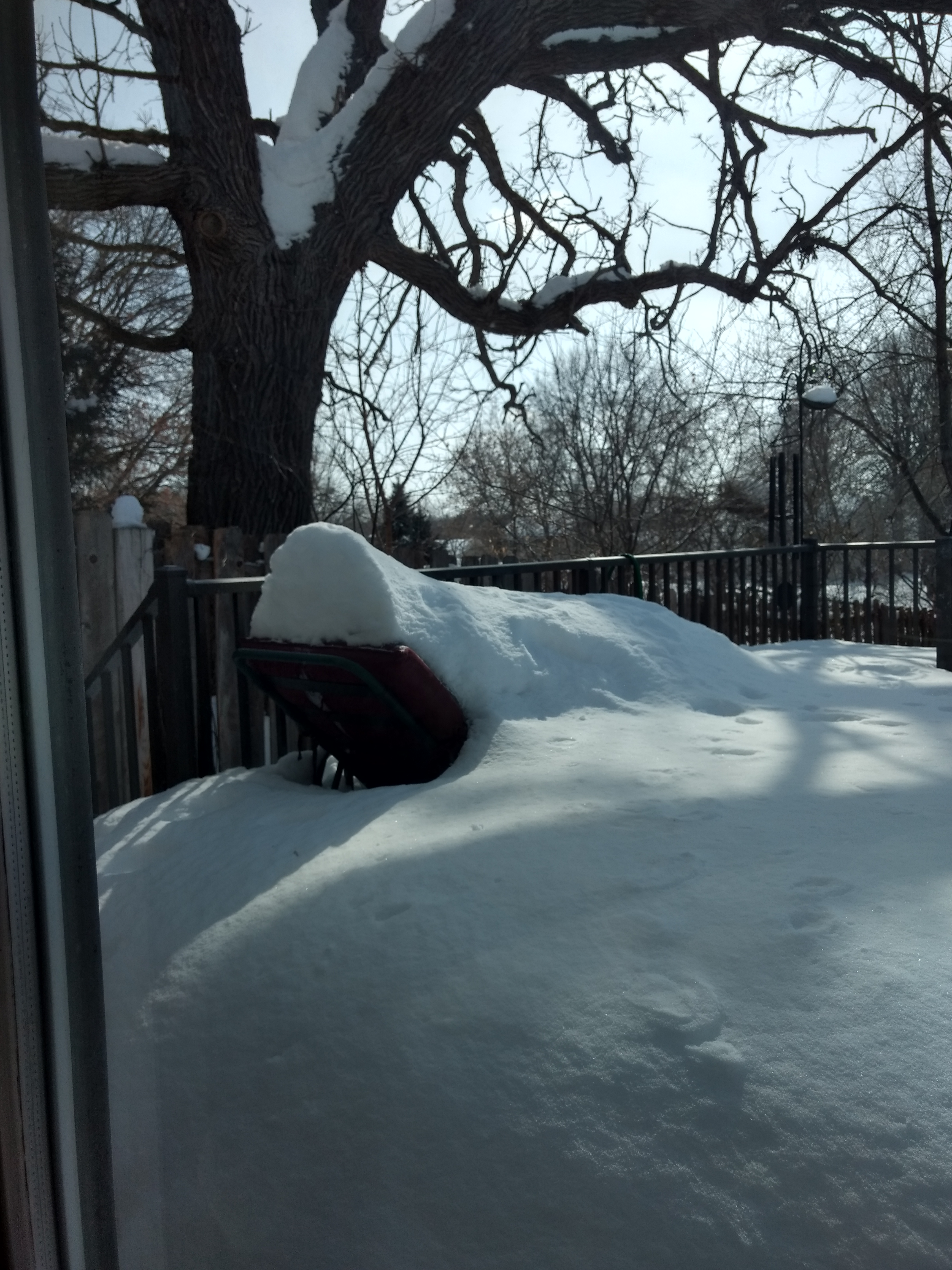
You lazy snow
that's lounging on my deck.
Your shape has grown
from just
a crystal speck
to
such a walrus-like
atrocity.
I welcomed you
when
you were itty-bitty.
But now you seem to plan
an overstay.
I hear
more friends will soon be on their way,
and
as you occupy my back yard deck
my house thermometer,
I'll double-check.
For, like a lion,
March came stalking in,
where February's snows already been
to leave you
lying there in my deck chair.
while growing
thick and debonair.
So,
soon there'll be warming sun,
I pray,
to take your chilly friends,
and you,
away.
I'll watch,
as you so slowly
melt and shrink,
and by my window,
sit and sip my drink.
| Author Notes |
This visitor appeared during February, more snow expected this week. I measure about 2.5 feet in depth so far.
This poem is A Faux Free Style. A Free Style poem is a type of Free Verse with rhyming, usually incidental. What makes this Faux Free Style, is that although I has the look of a Freed Verse poem, it actually has aabb rhyming, as well as iambic pentameter. I took this picture today, 3/5/2019. |
|
You've read it - now go back to FanStory.com to comment on each chapter and show your thanks to the author! |
![]()
| © Copyright 2015 Treischel All rights reserved. Treischel has granted FanStory.com, its affiliates and its syndicates non-exclusive rights to display this work. |
© 2015 FanStory.com, Inc. All Rights Reserved. Terms under which this service is provided to you. Privacy Statement